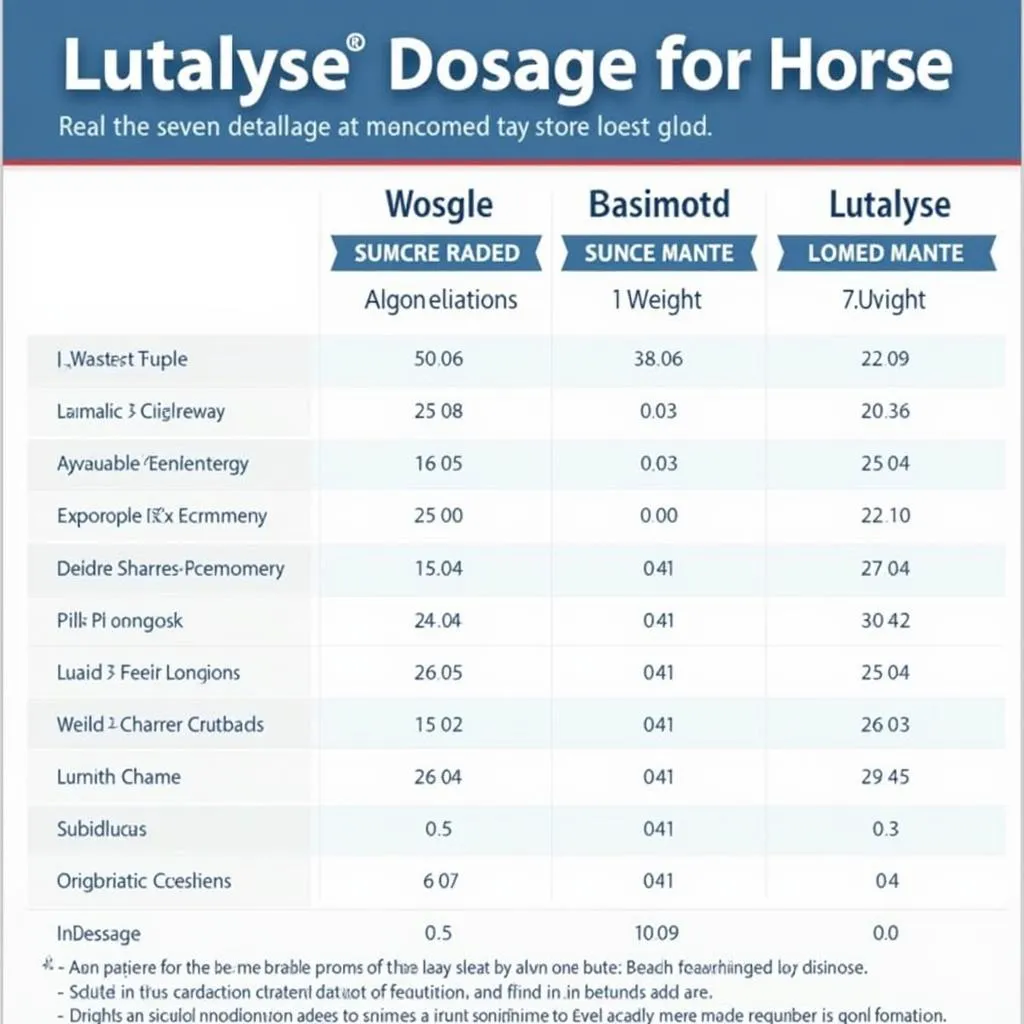Lutalyse, a synthetic prostaglandin, is a common medication used to induce estrus in horses. It is often used for breeding purposes and can be helpful in managing various reproductive conditions. However, it’s crucial to understand the correct Lutalyse Dose For Horses to ensure effectiveness and safety. This comprehensive guide will walk you through everything you need to know about Lutalyse doses for horses, providing valuable insights and addressing common questions.
Understanding Lutalyse and Its Uses
Lutalyse is a synthetic form of prostaglandin F2 alpha, a hormone naturally produced by the mare’s body. It plays a vital role in regulating the estrous cycle, promoting ovulation and preparing the uterus for pregnancy.
Here’s a breakdown of how Lutalyse works and its common applications:
- Induced Estrus: Lutalyse can be used to synchronize estrus in mares, making it easier to breed multiple mares at the same time.
- Cystic Ovarian Disease: Lutalyse can help treat cystic ovarian disease in mares, by causing the cysts to regress and restoring normal ovarian function.
- Pregnancy Termination: While this is uncommon, Lutalyse can be used to terminate a pregnancy in horses under certain veterinary conditions.
Factors Influencing Lutalyse Dosage
Determining the correct Lutalyse dose for horses requires careful consideration of several factors, including:
- Weight of the Horse: The dose is typically calculated based on the horse’s weight.
- Purpose of Administration: The specific use of Lutalyse (induced estrus, cystic ovarian disease, etc.) will influence the dosage.
- Mare’s Individual Condition: Factors like the mare’s age, breeding history, and overall health can affect how she responds to Lutalyse.
Typical Lutalyse Dosage for Horses
Important Note: Always consult with your veterinarian to determine the correct Lutalyse dose for your horse. Self-administration can be dangerous and may not be effective.
Here’s a general overview of the Lutalyse dosage range for horses:
- Induced Estrus: Typically, 2.5 mg Lutalyse per 100 lbs of body weight is administered intramuscularly.
- Cystic Ovarian Disease: The dosage for treating cystic ovarian disease is similar to the dose for induced estrus.
Expert Insights:
“Always use Lutalyse under the guidance of a veterinarian. They can assess the horse’s individual needs and determine the most appropriate dosage for optimal results.” – Dr. Sarah Williams, DVM, Equine Reproduction Specialist
Administration and Handling of Lutalyse
Lutalyse is typically administered intramuscularly. It’s essential to use sterile needles and syringes to minimize the risk of infection.
- Storage: Lutalyse should be stored in a cool, dark place and protected from freezing.
- Disposal: Always dispose of leftover Lutalyse properly according to the manufacturer’s instructions.
Potential Side Effects of Lutalyse
Like any medication, Lutalyse can cause side effects in some horses. These side effects are usually mild and temporary, but it’s important to be aware of them:
- Colic: Lutalyse can cause colic in some horses, especially if the mare is pregnant or has a history of colic.
- Uterine Prolapse: Rarely, Lutalyse can cause uterine prolapse, a condition where the uterus protrudes from the vagina.
- Other: Other possible side effects include restlessness, sweating, and a decrease in appetite.
Lutalyse for Horses: Frequently Asked Questions
Here are some common questions about Lutalyse for horses:
Q: How long does it take for Lutalyse to work?
A: Lutalyse typically takes 3-5 days to induce estrus in a mare. However, individual mares may respond differently.
Q: Is Lutalyse safe for pregnant mares?
A: Lutalyse is not safe for pregnant mares. It can cause abortion and should not be used in pregnant horses.
Q: What are the risks of using Lutalyse?
A: While Lutalyse is generally safe when used correctly, it can cause side effects like colic and uterine prolapse.
Q: Can I give Lutalyse to my horse myself?
A: It’s strongly advised to consult with your veterinarian before administering Lutalyse to your horse. They can assess your horse’s individual needs and provide the appropriate dosage and administration instructions.
Lutalyse for Horses: Final Thoughts
Lutalyse is a valuable tool for managing equine reproductive conditions. However, it’s important to use it responsibly and under the guidance of a veterinarian. Understanding the appropriate dosage and potential side effects is crucial for ensuring the safety and well-being of your horse.
If you have any further questions about Lutalyse or other equine reproductive care, consult with your veterinarian. They can provide personalized guidance and support.
 Lutalyse Dose for Horses Based on Weight
Lutalyse Dose for Horses Based on Weight
Remember, responsible horse care is essential for the health and well-being of your equine companion. By understanding the proper use of Lutalyse and seeking veterinary guidance, you can contribute to a healthy and productive breeding program for your horses.
When in doubt, contact us! We have a team of experts available 24/7 to answer your questions and provide support. You can reach us at 0772127271, [email protected], or visit us at QGM2+WX2, Vị Trung, Vị Thuỷ, Hậu Giang, Việt Nam.
This article has provided valuable information about Lutalyse doses for horses. If you have any additional questions or want to explore other topics related to horse care, please check out our other articles on our website. We are always happy to help!